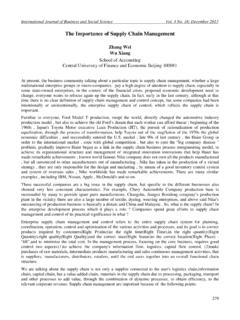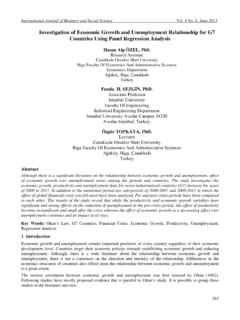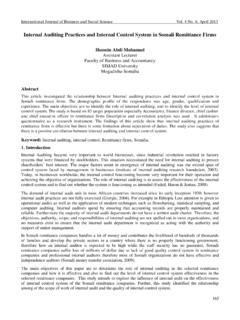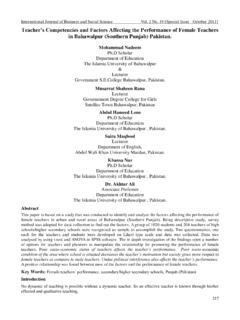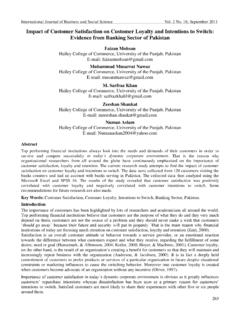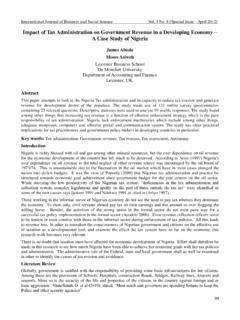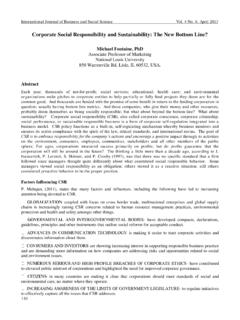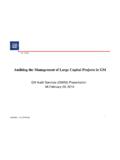Transcription of Cultural Differences and Communication Issues in ...
1 International Journal of Business and Social Science Vol. 3 No. 3; February 2012 116 Cultural Differences and Communication Issues in International Mergers and Acquisitions: A Case Study of BenQ Debacle Shuhui Sophy Cheng Assistant Professor Department of Communication Arts Chaoyang University of Technology 168 Jifeng E. Rd. Wufeng District Taichung 41349, Taiwan Matthew W. Seeger Professor Department of Communication Wayne State University 585 Manoogian Hall Detroit, MI 48201, USA Abstract BenQ, a Taiwanese-based company, grabbed the international headlines on June 7, 2005, when it acquired the money-losing mobile phone division of Germany s Siemens and launched the brand, BenQ-Siemens. Subsequently the acquisition proved to be a strategic mistake, as the two companies could not successfully integrate. This article tracks BenQ s acquisition of Siemens, from the perspective of BenQ, through a qualitative case study.
2 The analysis focuses mainly on culture and Communication Issues in what became an unsuccessful acquisition. The results indicate that the German Siemens and Taiwanese BenQ are different in important ways, from national culture to organizational culture. BenQ s failed acquisition of the Siemens handset was a wakeup call, providing a valuable lesson to other companies planning to create their own global brand recognition. The issue here is the extent to which the two companies incompatible cultures made it unlikely that they could add value and create synergy. This study concludes that an international merger and acquisition has a better chance of success when managers consider the host country s culture and allocate enough time and resources for assimilation. Furthermore, managers need to communicate and clearly define objectives and performance expectations during the integration and implementation process. Keywords: mergers, acquisition, intercultural Communication 1.
3 Introduction Taiwan has spawned many top-tier electronic component vendors and contract manufacturers. As profit margins for contract manufacturing begin to shrink, Taiwanese executives see moving beyond low-cost manufacturing as vital for a profitable future. Taiwanese companies try to make a shift from being an anonymous contract manufacturer to building their own brand names. One way to an immediate global presence is to acquire an attractive existing brand. In this case, it was Siemens. BenQ, a Taiwanese based company, grabbed the international headlines on June 7, 2005, when it acquired the money-losing mobile phone division of Germany s Siemens and launched the new brand, BenQ-Siemens. With the merger, BenQ Mobile became the world s fourth largest mobile phone brand after Nokia, Motorola, Samsung (BenQ Press Release, 2005). However, the acquisition of Siemens s mobile phone unit lost over 500 million euros in 2005, with little sign of financial recovery.
4 In late September, 2006, BenQ decided to stop investing in the money-losing operation and filed for bankruptcy protection in Germany. Barney (1988) indicates that an acquisition creates value for the acquirer when it achieves synergy and adds unique and valuable resources that can be leveraged into the target organization. A common objective in acquisition practice is to bring together companies and enhance the competitive position of the companies through the transfer of complementary capabilities between them. This synergy is often used as a justification for mergers and acquisitions (Fitzgibbon & Seeger, 2002). Centre for Promoting Ideas, USA 117 Similarly, Chairman K. Y. Lee told reporters at a press briefing in Beijing, China, that BenQ would be able to make Siemens s debt-ridden mobile handset unit profitable in two years.
5 He pointed out We can achieve a profit quickly because we have sales and distribution channels globally. We complement each other. What Siemens has, we don t. What we have, Siemens doesn t ( BenQ boss sees Siemens unit turning profit in 2007, 2005, ). However, in the case of BenQ-Siemens, the merger failed to create synergy and more value than each company could achieve alone. As international mergers and acquisitions (IM&As) are usually very complex and demanding processes, they result in unique organizational learning (Hitt, Harrison, & Ireland, 2001). There are many factors that link success or failure to the process of IM&As. The existing literature, however, takes mostly a financial and/or economic perspective, measuring the outcomes of IM&As in the market share or short term, while their long-term effects and nonfinancial factors remain untouched (Andrad, Mitchell, & Stafford, 2001). Filling the gap left in current literature, this article tracks this acquisition, from the perspective of BenQ, through a qualitative case study and focuses mainly on Cultural Differences and Communication Issues manifest in this unsuccessful business marriage.
6 The aim is to provide a thick, detailed description of the effect culture and Communication had on the outcome of this BenQ-Siemens acquisition. 2. Background of BenQ s Acquisition of Siemens BenQ, established in 1984, was initially known as Acer Peripherals Inc., and later rebranded in December 2001 as BenQ. For years, BenQ had been a consumer electronics contract manufacturer. It quickly expanded to include clients such as the giant cell phone brands, Motorola and Nokia. Chairman Lee frequently cited Steve Jobs of Apple as a key source of inspiration and especially admired the way Jobs nurtured the Apple brand (Einhorn, 2004). Lee noted that technology changes so fast, and consumer habits are changing all the time. The only thing a company has in the long term is the brand name and the management philosophy (Einhorn, 2004, p. 26). With this in mind, Lee not only shifted his focus away from being a contract manufacturer and more towards the production of self-designed products, but he also promoted the BenQ brand image.
7 Lee sought to develop a globally recognized brand image, increase the product line and expand its contract manufacturing business. When the opportunity came, Chairman Lee took a shortcut strategy to the global mass market. On June 7, 2005, BenQ acquired the ailing mobile devices division of Germany s Siemens. Lee said at the press conference, BenQ has been seeking ways to boost its economic scale and manufacturing capabilities to become a leading mobile phone player. We think Siemens is a partner that will be complementary (Wang, 2005, p. 1). On the other hand, Siemens was expected to regain investor confidence through the selling of their money-losing mobile phone unit, and shifting its focus to its more profitable industrial operations, including power turbines and automation equipment. Under the agreement, BenQ acquired 100% of Siemens s mobile-devices unit without directly paying the German company. Instead, Siemens provided BenQ with 250 million euros to help fund the business, and later paid 50 million euros to buy newly issued shares in BenQ.
8 In addition, Siemens continued to carry the unit s losses, about million euros a day, until the transaction was completed in September 30, 2005 (Dean, Karnitschinig, & Pringle, 2005). Siemens also continued to work with BenQ on developing handset technologies. As part of the transaction, BenQ gained the exclusive right to use the Siemens trademark for mobile phones for an 18-month period and co-branding rights to BenQ-Siemens for 5 years. It was estimated that this deal cost Siemens about 350 million euros. Meanwhile, BenQ agreed to fulfill Siemens s labor contract agreements with the cell phone employees through the end of 2006 (Dean, Karnitschinig, & Pringle, 2005). In response to this transaction, the shares of Siemens jumped to euros, up 3%. In contrast to the optimistic view of Lee, however, BenQ shares went down on the Taiwan Stock Exchange when the purchase of Siemens s handset division was disclosed.
9 The new business division, BenQ Mobile, started its operation on October 1, 2005. The new company was headquartered in Munich, Germany and had over 7,000 employees worldwide working on research and development, design, sales, and marketing. BenQ, however, suffered from growing pains after its acquisition of Siemens. Although Siemens s handset operation increased BenQ s strengths by allowing it to directly compete with other leading brands, there was also a conflict of interest with BenQ s current leading customers. By September 28, 2006, BenQ announced that in order to manage the losses, it would stop pouring money into BenQ Mobile its German mobile phone subsidiary (BenQ Press Release, 2006). International Journal of Business and Social Science Vol. 3 No. 3; February 2012 118 The subsidiary filed for insolvency protection in a Munich court a move to protect the interest of creditors.
10 Its management was handed over to a new team appointed by the German government leading to a public outcry in Germany due to the loss of nearly 3,000 jobs. 3. Literature Review IM&As operate within the two entities of their home ( , headquarters) and host ( , subsidiary) cultures. This situation creates conflict over the degree of Cultural adaptation. It has been argued that Cultural Differences can create major obstacles to achieving integration benefits (Bjorkman, Stahl, & Vaara, 2007; Stahl & Voigt, 2008). Consistent with this idea, Hofstede (1980, 2001) suggests that the conflicts, costs, and difficulties associated with cross-border contact increase with growing Cultural Differences between two organizations. Clashes between different organizational practices may arise from national Cultural barriers, language problems, different legal systems, and regulatory hurdles (Shimizu, Hitt, Vaidyanath, & Pisano, 2004).


